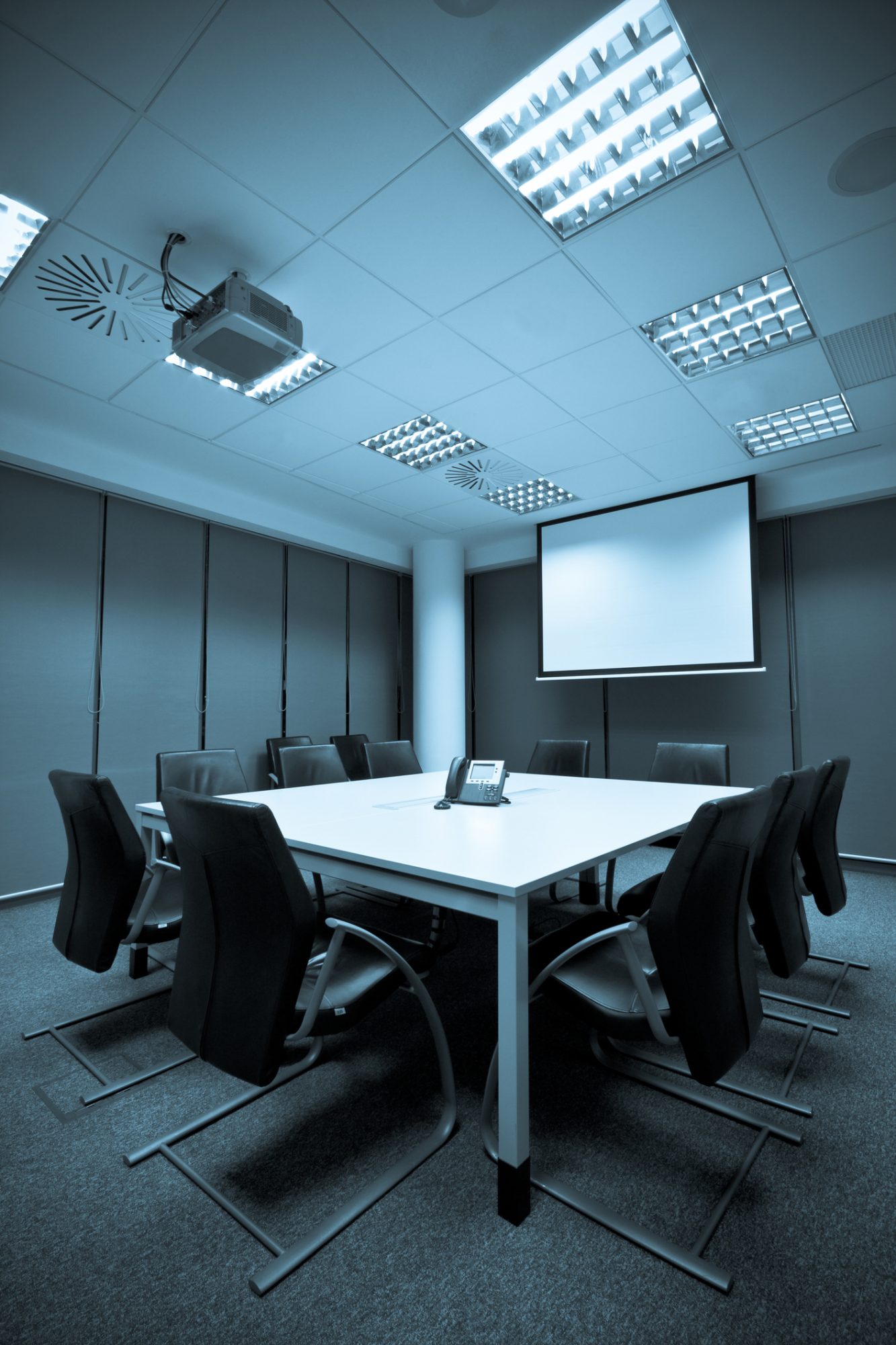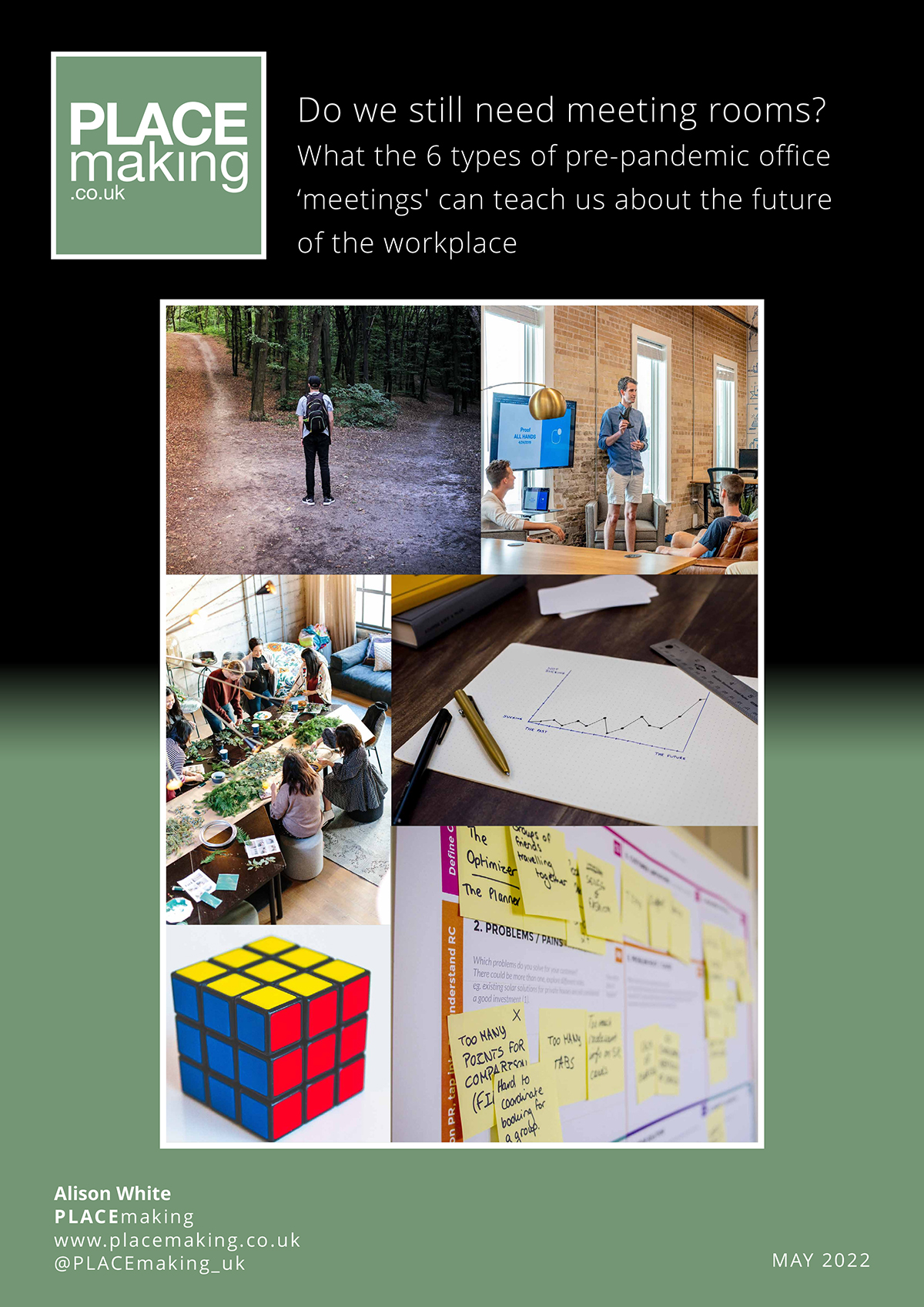Do we still need meeting rooms? What the 6 types of pre-pandemic office ‘meetings’ can teach us about the future of the workplace
In the general world of work, pre pandemic there were six acknowledged types of organisational activities generally associated with the generic term of a having a ‘meeting’.
For instance:
- Decision making – generally senior management;
- Status updates or Town Halls;
- Progress reporting;
- Team building;
- Problem solving;
- Innovative brainstorming.

Each of these activities have very different purposes and desired outcomes, but essentially all of them are focused on communication – that might be one way broadcast messaging or open contributing engagement. Some are carefully choreographed by way of a heavily scripted and timed agenda with decisions carefully recorded. Others more spontaneous, less formally co- ordinated with participants gathering on the basis of their relevance to the matter in hand whilst others could be described as being routine occurring at regular intervals and with a predictable pattern of information gathering.
Yet how many of us actually understands the type of event or even the purpose of a meeting we are invited to or instructed to attend? How many of us know why we’re there, what expectations there are of us and what value the event has to us getting through our contracted tasks or to the objectives of the organisation we are contracted to?
If you ask people who host meetings, why they had arranged the meeting and what the purpose is they often say this is to:
- Find out what’s happening;
- Ensure progress is being made;
- And to hold to account someone doing something they’re not happy about.
If you ask regular attendees to such meetings, what was the purpose of the meetings?, they admit that most are generally a complete waste of time and if they did know what the original objectives were, they were almost never achieved. Most meetings have no clear purpose, poor quality outcomes and attendees are convinced they’d be better off spending the time doing something more productive.

They also report how the room the meetings are held in can have a significant impact on their meeting experience is. Most can list meeting rooms that they avoid booking and not always for obvious reasons. Yes, these rooms are often under equipped, too small to do anything more than sit round a cramped table and often have no windows, no fresh air or are poorly ventilated. But even rooms that have these missing features are also unpopular and it seems that this is as a result of the attempt to standardise and commoditise these spaces so that they are so non-specific that they actually meet no-ones needs.
The assumption being that making the rooms as generic as possible better match the overall capacity with the endless demand for meeting rooms and therefore drive-up utilisation. In fact, actual utilisation of meeting rooms, rather than the booking of meeting rooms across multiple sectors on average hovered at around 26%, utilisation of poor regarded rooms very noticeably lower and of course popular rooms significantly higher.
So, if going to meetings is so often regarded as a waste of time and the spaces, they are often held in so variable both impacting directly on our experience, then why do meetings continue to be arranged and why do so many of us feel compelled to go to them?
A quick trot through history might shed some light. Meeting rooms had a specific function in times past when business management methods were slower and more formal. Most organisations had a small number of meeting rooms, and these were exclusively used by senior management grades. On the whole managers had their own offices, the more senior you were then the larger your office, justified because meetings were held in them. Junior grades offices or access to meeting rooms, their task was to generate information for their seniors to discuss in their exclusive meetings. The board room was of course the most special of all and only used by senior management and for very formal meetings.

Back then collecting information was generally a manual process: administrative teams processed specific performance information in paper reports that were collated and passed to senior managers via multiple management layers. The entire process was mechanistic, and on the whole, the only people who had full view of all of the business performance information were senior management, although they might not have shared everything they held – after all information was power and political manoeuvres at senior management level was not unknown even then. Senior Management meetings were confidential and inevitably happened in private meeting rooms and behind closed doors where something apparently magical happened because at the end of the meeting instructions were passed down the chain of command to the shop floor to “do something different/faster/better/etc.” and then of course the same reporting process starting all over again for the next round of meetings.
The meeting room was the hub, the command- and-control centre and one that only a very few were ever invited in to. As with anything that appears ‘exclusive’ those meeting rooms had some sort of aura, sometimes positive but often negative. They were regarded with respect, almost a holy place that you’d wipe your shoes before entering and walk on a plush carpet. People feared being unexpectedly instructed to attend a meeting and black humour highlighted that attendance inevitably resulted in being given the sack. Such cultural imprints were shared between work colleagues and those new to the workplace soon picked up on the exclusivity of the meeting room – it was for the special ‘few’ and not for the general ‘all’.
With the introduction of computer systems, more ‘real time’ information on what was happening on the shop floor was available and managers were required to have a better handle on productivity and costs. Organisations started to import new ideas and business methods from the US and keen to get more ‘order’ in their business practices, the office layout changed. Designers developed ‘space standards’, more military-style allocation of space by function and not just by grade. Manager offices started to disappear as more democracy of information was available via the PC. The dominant single management pyramid of the past started to change. Flatter structures emerged with smaller pyramids and clusters of people collating information on specific areas of business. The role of senior management changed too: it needed to ensure it kept pace with information from the mini pyramids, making sure they themselves didn’t become silo’d in their perspective and blind to the bigger picture.
As a greater number of people had access to information, then the number of management grades increased and with that came a greater demand for meeting rooms – after all that’s the learned cultural expectation: managers spend large amounts of their time in meetings and as a consequence in meeting rooms. Look at the vast majority of meeting rooms and aside from different sizes and levels of decorative investment, they are all pretty much the same. A table with chairs on all side so that sitters face inwardly and opposite each other. In fact this blueprint made perfect sense in that past as we were all physically present and the focus was on hearing what we each had to say and validating agreements and actions.
How meeting rooms were updated
Gradually technology was introduced in to meeting rooms with large format screens often added on the wall at one of the table but aside from that rooms went largely unchanged. The introduction of the large screen though changed the focus from across the table to one end making it somewhat awkward for everyone to now focus on the screen, craning their necks in one direction to view what was displayed often away from eye contact with the presenter of the information. All regarded as being very ‘modern’ and the same blueprint was replicated across multiple meeting rooms without understanding the consequence. In place of active interaction, participation in meetings became passive with participants now observers and absorbers of presented information. This same blueprint room is often all that is on offer irrespective of the very different purposes and desired outcomes of the six different types of activities any healthy functioning organisations needs to facilitate. Development of new, upgraded and relevant to task solutions is essential to get the best possible value from time spent interacting and collaborating.

What impact will hybrid working have on meetings and meeting rooms?
These same room layouts, furniture solutions and technology assets are now being used for meetings with participants increasingly attending digitally with only some physically in the room. With limited focus on investing in the physical infrastructure and preparing people for successfully hosting and participating in such hybrid ‘meetings’ there is a risk that what should be new opportunities fall in to the same trap of frustrating the participants and failing to creatively meet new challenges and expectations.
Conclusions
Having a meeting and being in a meeting room could be simply a comfort to us – we might not like going to them or being in the typically dull room where they are held but for those of us responsible for providing and managing them, not having them or swapping them for something unfamiliar seems to worry us so we keep on with them until someone proves there is another, better solution.
For those that are expected to attend meetings though we need to be convinced that time spent meeting others will be rewarding: there is an agreed reason to be together, a clear objective and we want to think for ourselves how best we can contribute – in person or digitally attending. When we do invest in meeting others, we want facilities to be available that are richer in quality and variety, spaces that inspire us to innovate, problem solve and envisage better ways to achieve shared objectives that add value to our common purpose.
We want spaces that we can adapt and arrange in whatever way we think will best meet our needs and tasks and reflecting how we are participating. The connectivity of everyone should be equal enabling everyone to participate on the same terms and not giving priority just to those who are physically present. We all have limited time to waste so we expect intuitively functioning technology with materials, tools and equipment on hand, which is fully functioning and complete. In other words, we want properly serviced solutions relevant to modern ways of working.
How do we know we need to upgrade our meeting culture?
You can start by looking carefully at your own diary – if you have meetings in your diary two weeks ahead of today and you have no real idea why you’re going to them-then it’s time to think afresh about your meeting culture.
If you are already hybrid working and joining meetings via Teams or Zoom, is it a positive experience, do you feel your contribution is equally regarded as those actually in the room? If not, your organisation needs to change how it operates.
If more than 30% of your total office space has desks in it and meeting rooms are the only alternative option to get away from the desk, then it’s time to review how your workplace is holding you back from achieving your future vision and business expectations.
Look at the next meeting room you use – does it inspire you or is it simply a space with a table, some chairs and a bit of technology stuck on a wall.
Have you got a variety of spaces available that reflect the 6 different meeting activity types or are they all pushed into the same meeting room type?
If you and your colleagues have adopted hybrid working does your office inspire you to spend any time there, collaborating with colleagues or do you resent the time spent even getting there and back?
Look at the next meeting room you use – does it inspire you or is it simply a space with a table, some chairs and a bit of technology stuck on a wall?
Have you got a variety of spaces available that reflect the 6 different meeting activity types or are they all pushed into the same meeting room type?
If you and your colleagues have adopted hybrid working does your office inspire you to spend any time there, collaborating with colleagues or do you resent the time spent even getting there and back?
Looking for more information, click the eBook


